More than 70% of companies consider their people analytics a “high priority,” and thanks to advances in technology (particularly human resources tech), companies have access to more people data than ever before. But while there’s no shortage of human resources metrics and formulas to track, there are a few that allow you to dig deeper and gain crucial insight about your people.
What are Human Resources Metrics?
Human resources metrics, or HR metrics, help your organization’s HR department determine the effectiveness of your initiatives, as well as aid the team in identifying any gaps in their practices.
These formulas and metrics help companies set and track goals over time and measure their progress. Findings, both good and disappointing, can help HR teams make informed decisions and take action.
The exciting news for employees is that there is a desire for better workforce metrics, with 53% of participants in a 2021 study reporting “their leaders’ interest in workforce information has increased in the past 18 months.”
The more information HR gathers, the more power they have to make transformative shifts within the workplace. But, as we’ve learned from Winston Churchill, President McKinley, and even Spiderman, with great power comes great responsibility. Once data is collected, it must be acted upon to meet new demands of the company and workforce.
Deloitte Insights notes in 2021 Global Human Capital Trends: “To identify metrics that can govern and guide 21st-century workforce strategies, organizations need to determine what questions can help them navigate the future effectively, not just more fully report on the past.”
We’ve gathered five HR metrics and formulas we believe do just that. The following will help you make important, data-driven people decisions so that you are more prepared to focus on strategic initiatives.
1. Source of Hire
An often overlooked source of data starts even before contracts are signed and the onboarding process begins: the employees’ source of hire.
By tracking the source of hire, your HR department can determine which recruiting avenues—job boards, referrals, or recruiters—are bringing in successful hires. This information helps your team determine which sources are beneficial to your hiring practices and which may need focused improvement.
Calculate each source of hire’s percentage using the following formula:
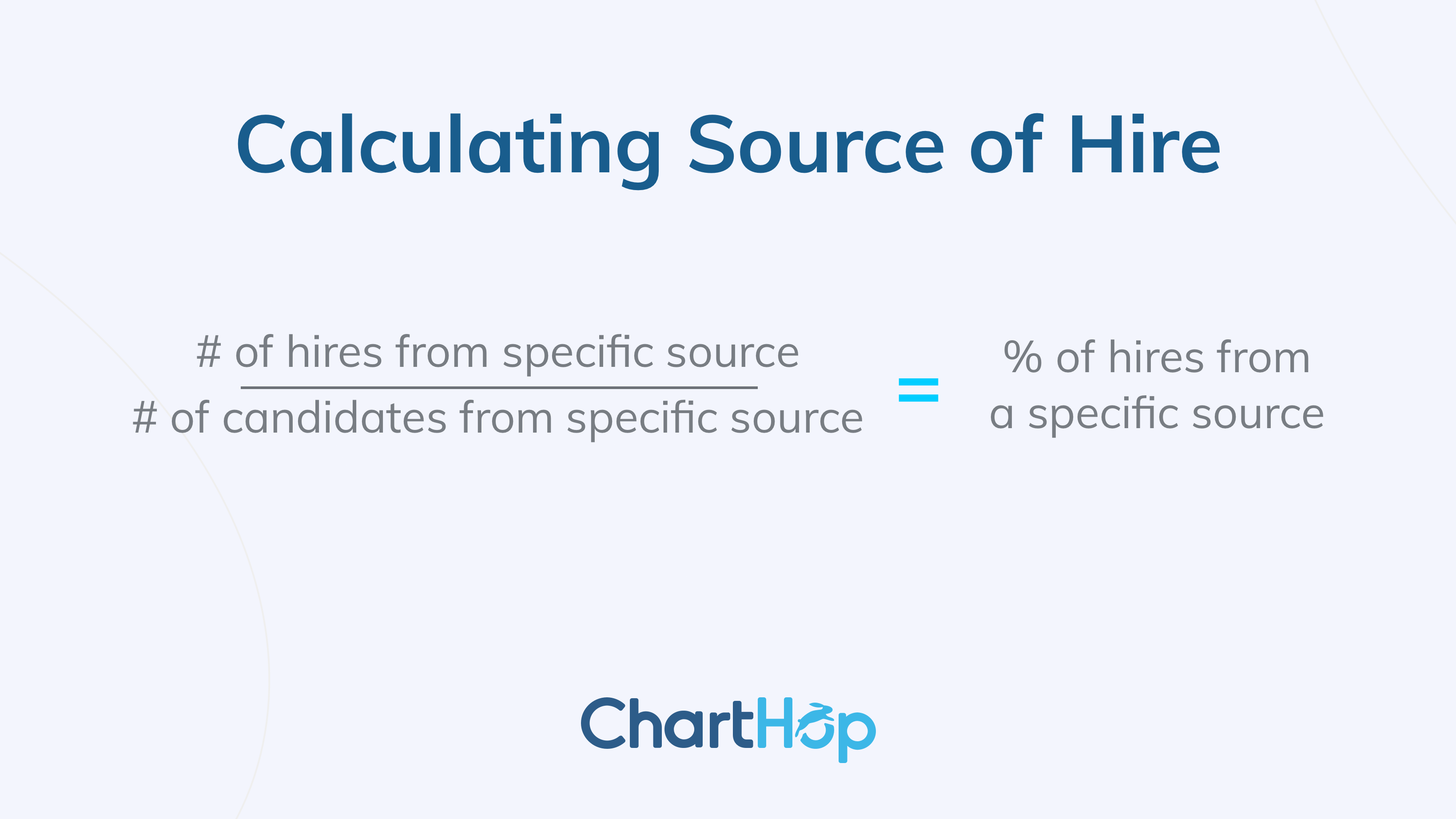
Why Does the Source of Hire Matter?
You attracted strong candidates, so why does their hiring source matter? In short, knowing how new hires find your company helps your HR team better allocate budget and effort. Having those hard numbers empowers you to focus on strategic initiatives, reallocate funds, and advocate for additional recruiting funding if your company has a major hiring need.
Ways to Use Source of Hire Metrics
- Identify your strongest source of hire and direct more of your budget there. Since you have determined that strong candidates come from this source, continue building and growing that momentum.
- Determine your weakest source of hire and analyze its flaws. Consider if it’s an alignment error (does the job description align with the qualifications you’re looking for?), personality match (does the language on your LinkedIn page match the personality of your company?), or a resource issue (did potential candidates fall through the cracks?). Direct funding and time to address these gaps in your recruiting practices.
- Focus on your top recruiter’s tactics. What do they do well? What professional opportunities have they had? Aligning the methods of your recruiting team will improve your organization’s health, save time, and improve employee experience.
Now Dig Deeper
Employee referrals remain a popular source of hire, as HR has to spend less budget recruiting these candidates. In fact, many companies now offer cash bonuses or paid time off as a reward to referees.
However, if one of your organization’s objectives is to grow a diverse workforce, referrals may hinder your progress.
A study by the Federal Reserve Bank of New York concluded that “most referrals take place between a provider and a recipient with similar characteristics in terms of age, gender, race/ethnicity, education, and staff level.”
That doesn’t mean you put an end to employee referrals, but adding an additional filter for gender or ethnicity to your source of hire metric can help you better address your diversity goals moving forward. And by prioritizing DEI, and even hiring a dedicated DEI team, your company will be competitive to job seekers and help promote a positive employee experience.
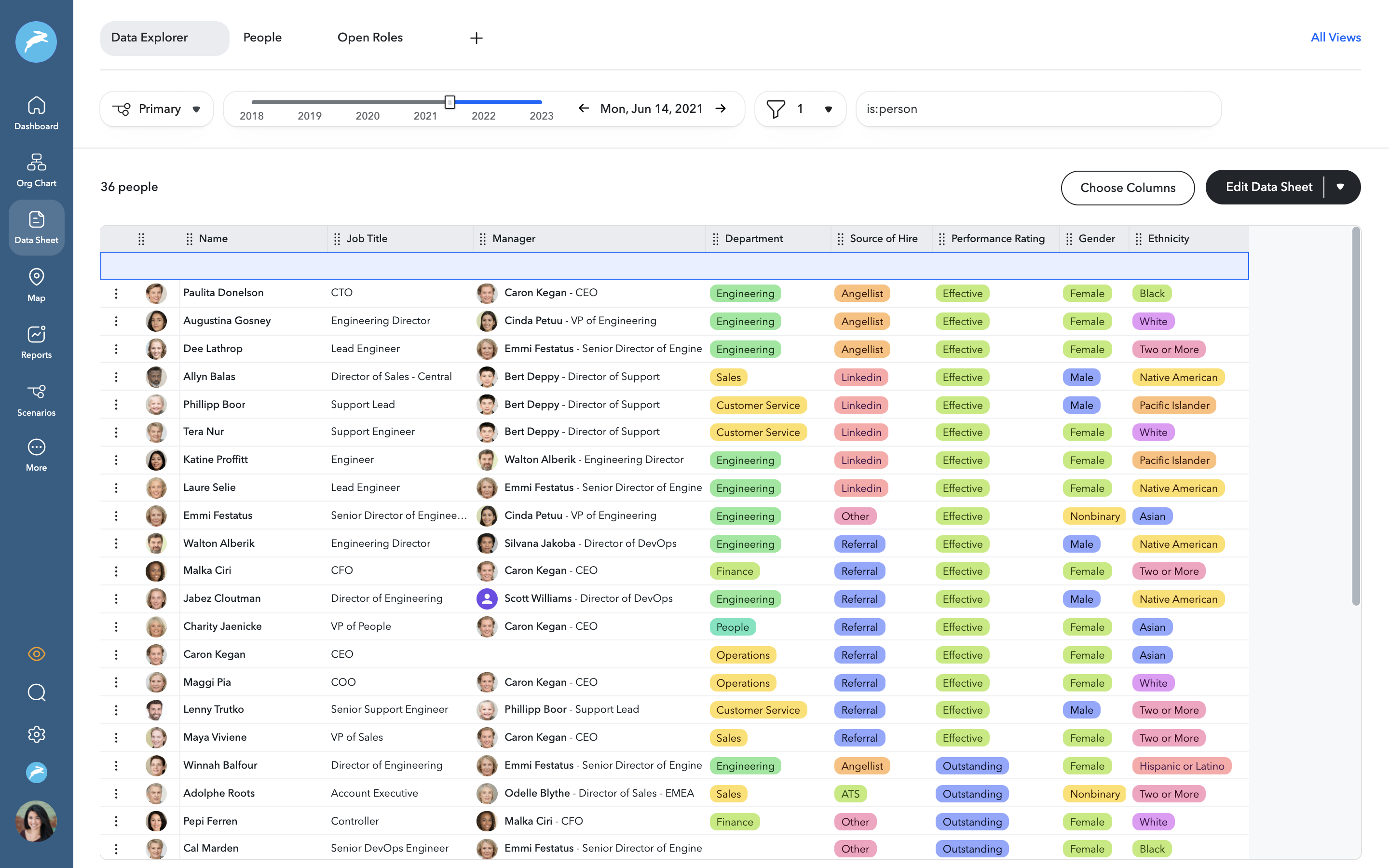
Sample Data Sheet with source of hire, demographic info and performance data
2. Employee Satisfaction (Using eNPS)
Did you know that companies that prioritize employee retention actually experience rapid business growth, growing their profits as much as three times faster than their competitors? One reason is because satisfied employees are more likely to stay and be company advocates. Therefore, every organization should regularly revisit their efforts to keep employees feeling fulfilled.
Surveys give employees a chance to voice their opinions and feelings about their work life. Employees’ answers will, in turn, give you actionable steps to improve organizational health.
So how can you learn how your employees truly feel? Comprehensive surveys that also take remote working practices, respect, and belonging into consideration help gauge employees’ overall satisfaction at work.
Although companies may think surveys are too time-consuming or expensive, the Employee Net Promoter Score (eNPS) survey gets right to the point with one question: How likely are you to recommend our company as a place to work? eNPS is a measurement best viewed over time, so some companies choose to conduct it monthly, quarterly, or semiannually.
Calculate your company’s eNPS score using the following formula:
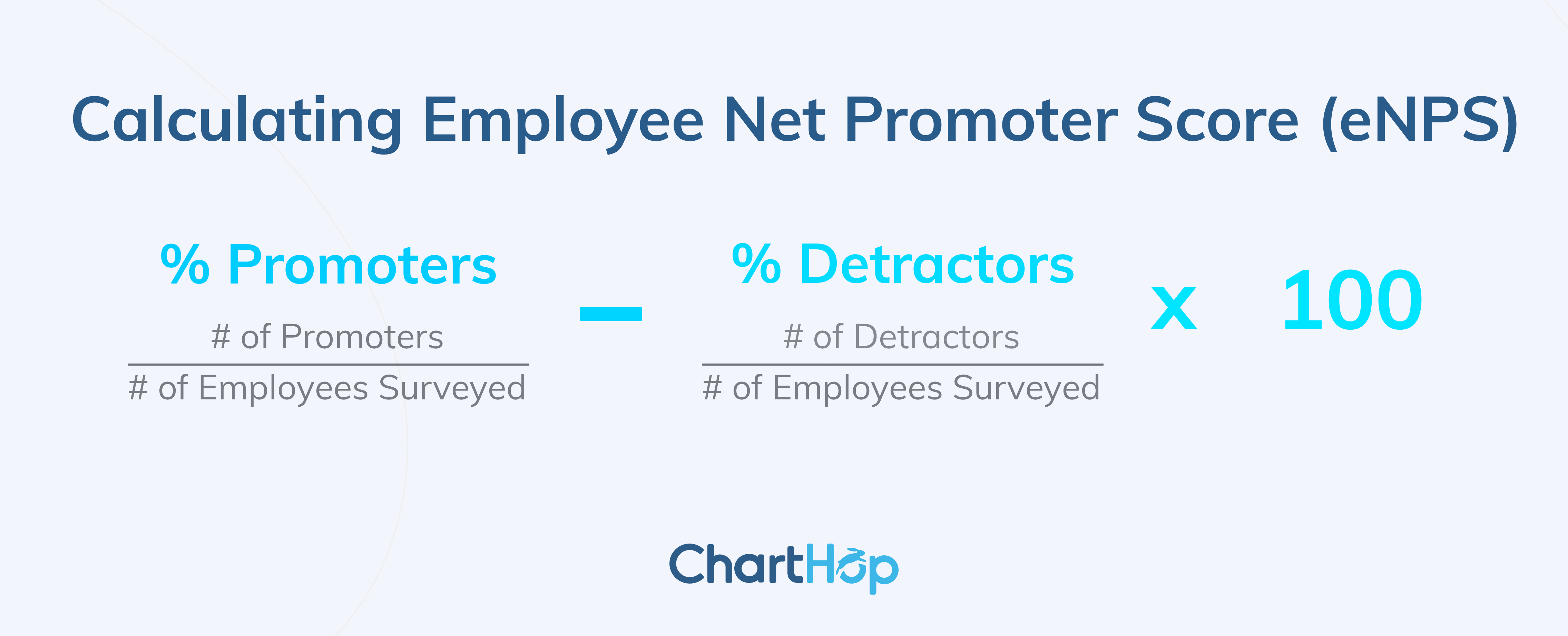
Why Does Employee Satisfaction Matter?
Companies want their employees to be happy at work. Positive, engaged employees make the work environment more enjoyable, which affects how employees feel about their company and how they interact with customers.
Data also shows that organizations with satisfied employees outperform those with a disengaged workforce. One study conducted by the UK government concluded that companies with highly engaged employees grew 19.2% in operating income. Another found that happy employees are 20% more productive than unhappy ones.
Employee satisfaction is a win/win for both the employer and employee.
Ways to Use Employee Satisfaction Metrics
According to Qualtrics’ 2020 Global Employee Experience Trends report, only 35% of respondents feel their company acts on their feedback “very or extremely well.” Collecting employee thoughts but failing to address your findings can damage trust between your company and your employees.
Feedback can be addressed whole group, small group, or individually, but the important part is that there is a response to the data collected.
Now Dig Deeper
Note that eNPS isn’t the only employee satisfaction survey available. While it offers employees anonymity that can encourage more honest scores, it provides little insight into satisfaction by key demographics or departments.
Consider conducting more in-depth satisfaction surveys annually, or if eNPS scores indicate unexpected dissatisfaction. These more robust surveys allow you to dial into various aspects of the employee experience, such as onboarding, day-to-day engagement, and team experience.
After gathering data, apply key filters to your findings that allow you to see a breakdown of satisfaction scores by race, gender identity, or a combination of both. By accumulating this specific data, you can further analyze any potential red flags or intersectionalities that may indicate feelings of dissatisfaction among a particular group of employees.
3. Promotion Rate
Tracking your company’s promotion rate helps you gauge how often current employees advance in your company.
Calculate your company’s promotion rate, either within or across departments, using the following formula:
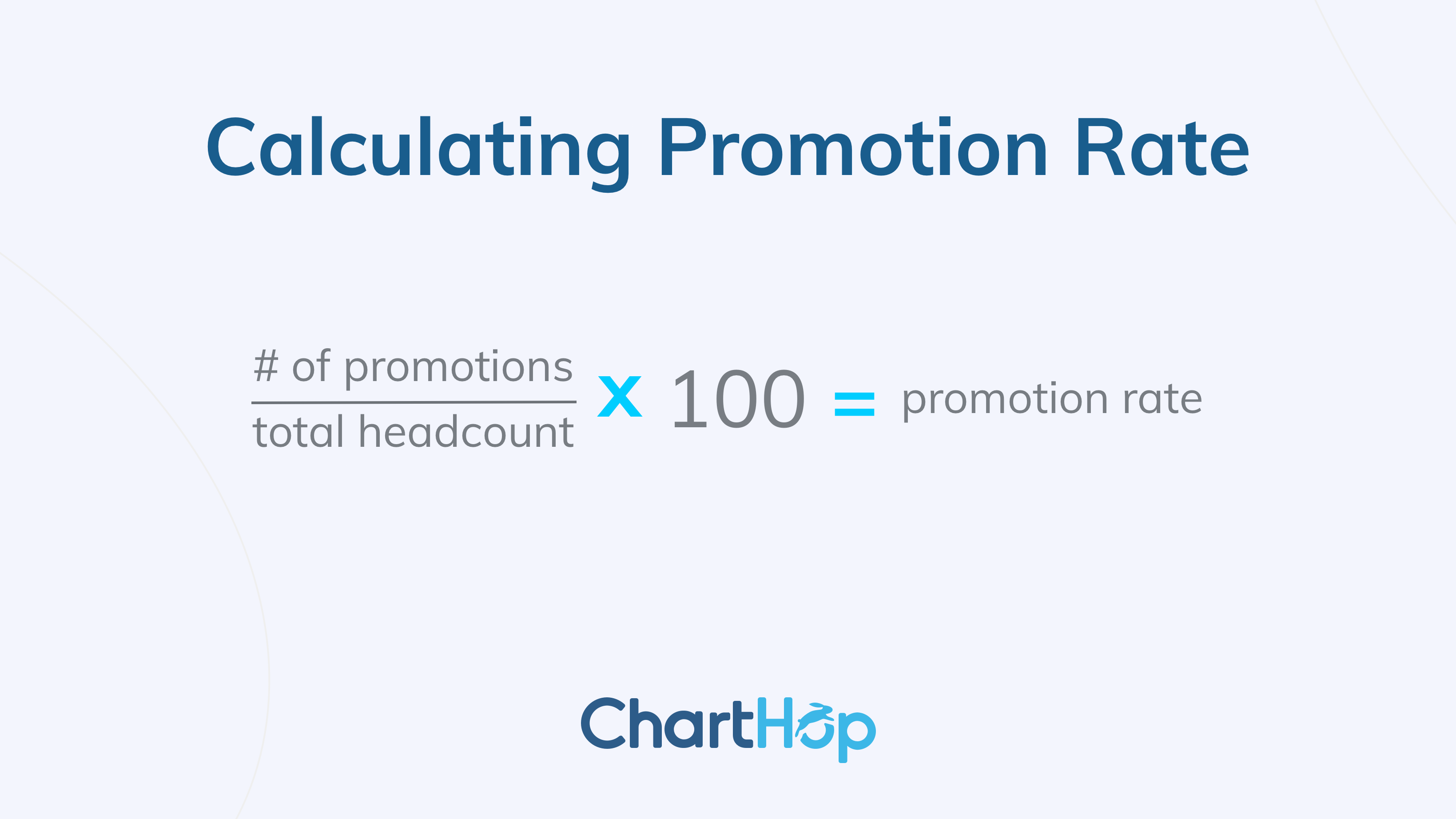
Why Does Promotion Rate Matter?
When a company chooses to fill an open spot internally, they already have a clear idea of that employee’s work ethic and performance. According to Performance Magazine, “internal promotions have the power to be more successful because there is more information available to make accurate decisions.” Increased employee satisfaction and reduced costs of recruiting and onboarding are other benefits to promoting internally.
Ways to Use Promotion Rate Metrics
A low promotion rate might also indicate a lack of growth trajectory or interfering circumstances. Consider viewing your promotion rate alongside other HR metrics, such as internal promotions versus external hires. If you are hiring external candidates to fill open positions before looking inward at current employees, you may want to shift your focus or analyze the company’s hiring practices altogether.
Now Dig Deeper
How transparent is your company about employee journey mapping? Sharing expectations, future opportunities, and timelines with employees demonstrates that the company is committed to their career and professional development.
And since employees are more likely to leave a job that offers little to no opportunity for growth, having these conversations early on or during performance reviews is a way to build trust and positive relationships with your staff.
4. Training time per employee
Employee training is an investment in your workforce, and it’s important that you regularly assess whether that investment is helping your company hit goals set by your leadership or training teams.
Training encompasses everything from compliance to job-related training to professional development. Training efforts can be broad, including large sessions, seminars, or off-sites, or smaller-scale lunch-and-learns and guided online modules.
Calculate training time per employee using the following formula:
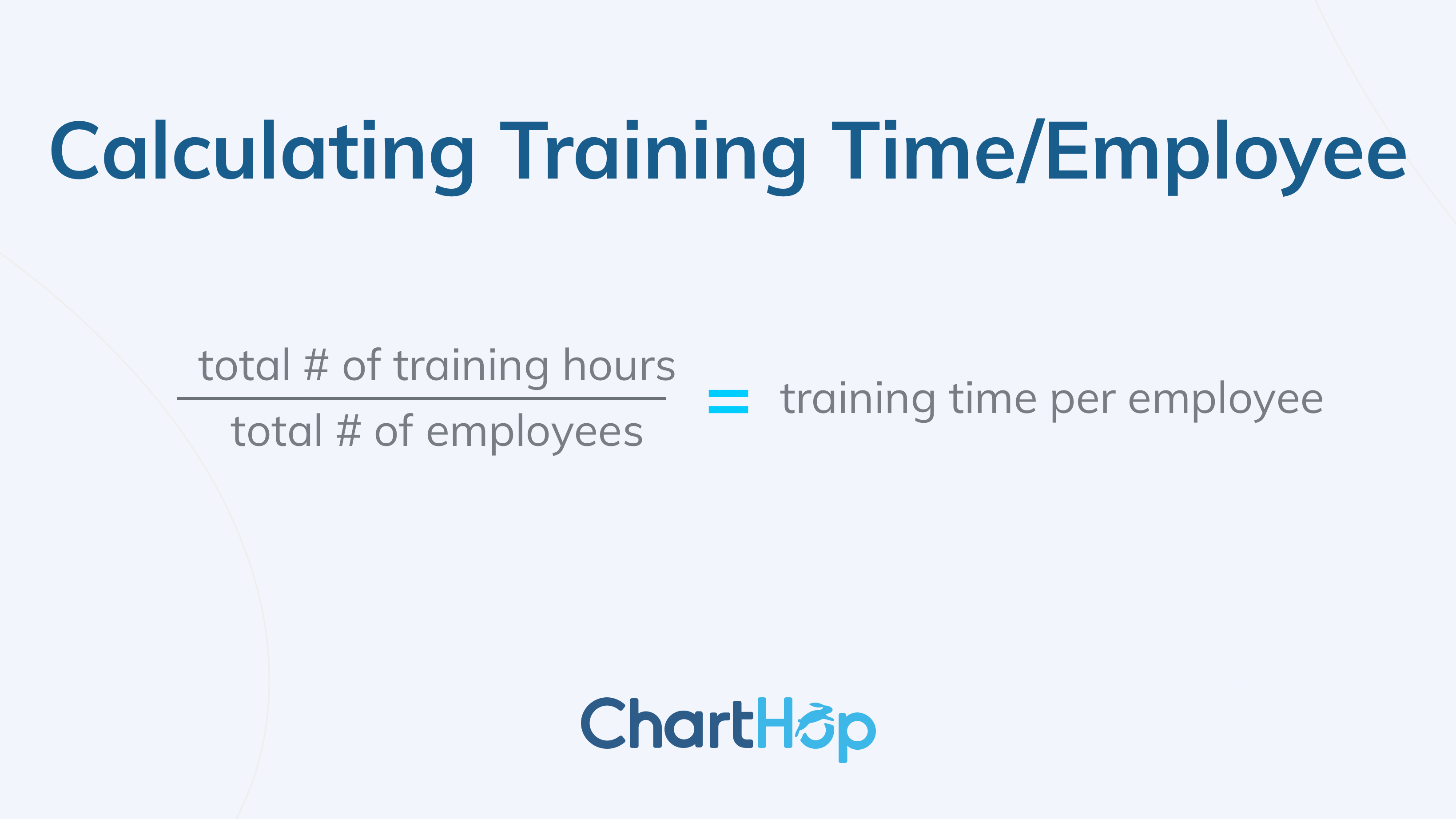
Why Does Training Time Matter?
According to LinkedIn’s 2019 Workforce Learning Report, 94% of employees say they’d stay longer at a company where they felt invested in their professional training and development.
“If employees don’t see you investing in their future with you, they’re going to look somewhere else,” says Brian Kropp, Gartner HR practice group Vice President.
Training can benefit your company’s growth, too: one survey found that 76% of employees believe that a company would be more appealing if it offered additional skills training to its staff.
Ways to Use Training Time Metrics
It’s important to invest in training opportunities across your entire company. Dialing into employee training metrics can help your team determine whether employees and departments are receiving equal access to training opportunities. Furthermore, knowing if you’re spending too little or too much time training employees will be helpful when analyzing and potentially reallocating time and budget.
- If too much time is being spent on training, consider which training needs to be person-led and which can be recorded. Recordings should be housed in a “one-stop-shop” so they can be easily accessed at any time.
- If lack of support during training is an issue, schedule 1:1 check-ins. New hires should be checking in with their manager and HR team regularly for the first 90 days to ensure a smooth onboarding process.
Overall, creating opportunities for continuous education signals to employees that you care about their professional and career development. Whether it’s promoting specific seminars, hosting speakers, or reimbursing for tuition, companies will benefit from their employees advancing their knowledge and skill set.
Now Dig Deeper
Middle management might receive leadership training, but that doesn’t mean individual contributors wouldn’t benefit from the soft skills, time management, and goal-setting training covered. Your company can also get creative with training opportunities. For example, create mentorship openings within your company to pair higher-level employees with those individual contributors who are interested in advancing.
5. Employee Turnover Rate
An employee turnover metric lets you view the rate at which employees are leaving your company in a given time frame. You can view turnover as overall turnover, or refine the HR metric to look at voluntary and involuntary turnover.
Calculate employee turnover (and voluntary turnover) using the following formulas:
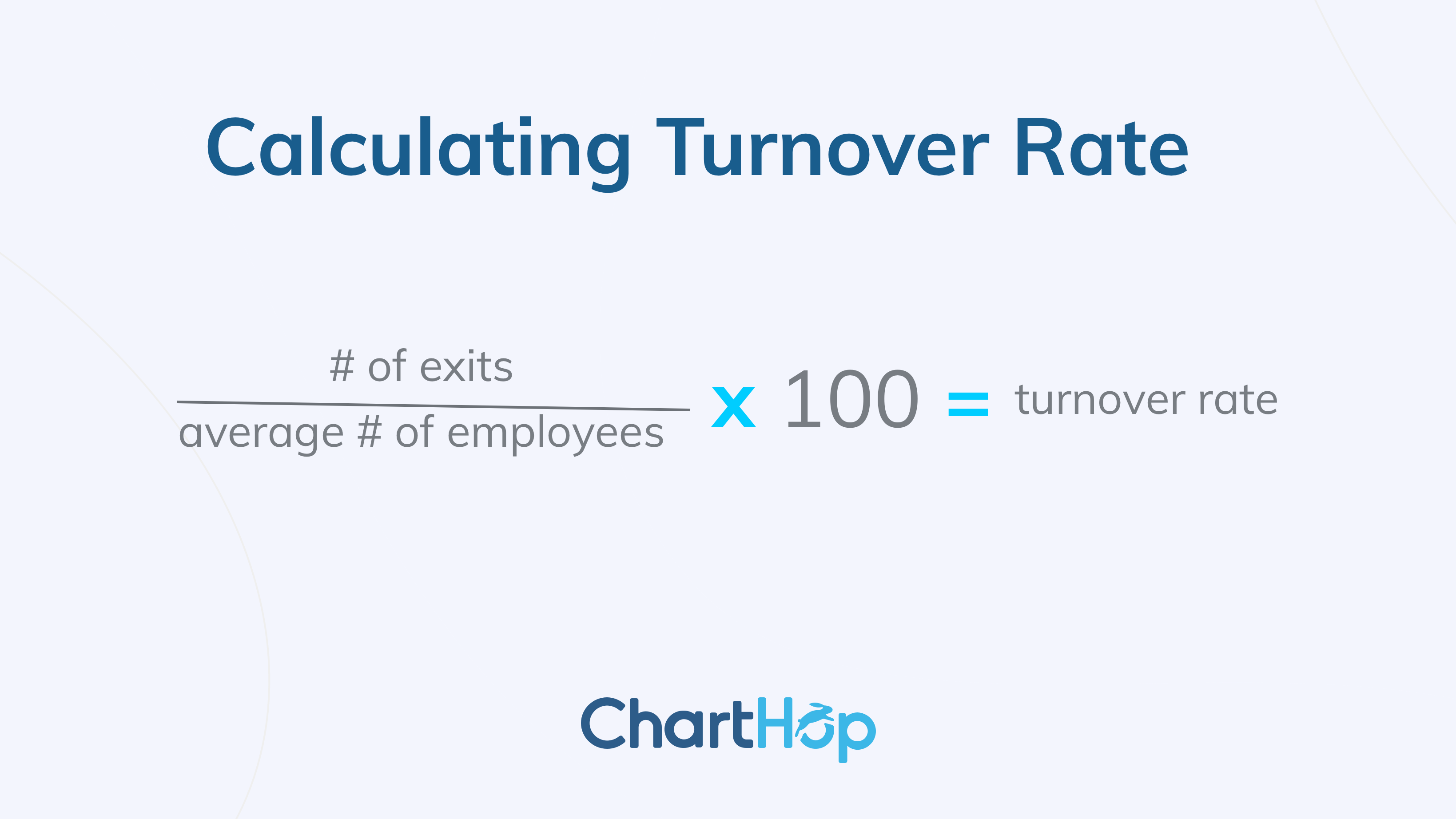
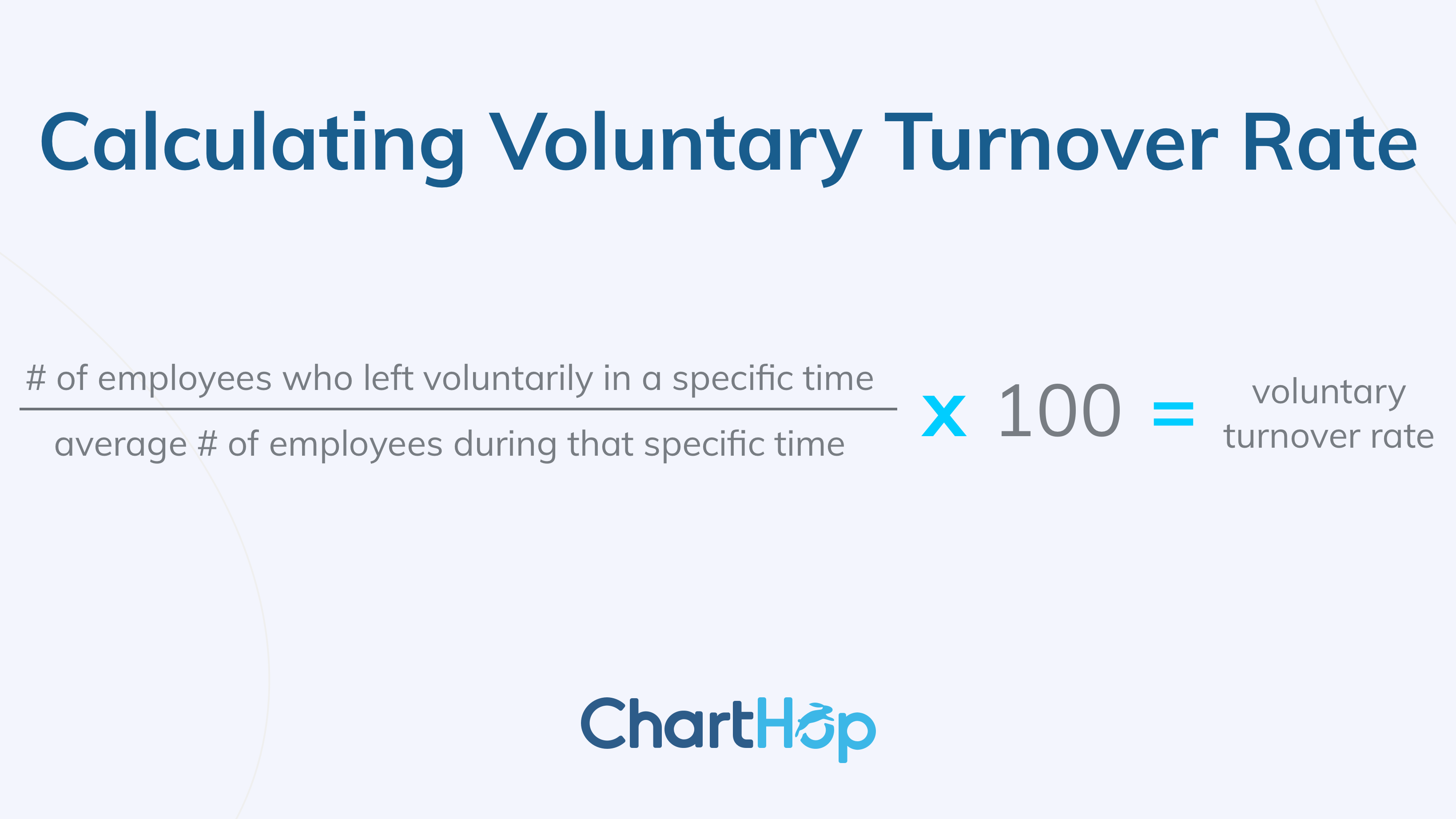
Why Does Turnover Rate Matter?
Over half of voluntarily exiting employees revealed that, in the three months prior to their exit, management failed to check in with them. No one asked them how they felt about work, about their satisfaction (or dissatisfaction), or what future they envisioned for themselves with the company. For some employees, doing so might’ve been enough to stop them from leaving.
Additionally, turnover is expensive. For a company of 100 employees, replacing staff can cost as much as $2.6 million per year. A high turnover rate, especially a voluntary one, can indicate issues with a manager, a team, or the company as a whole.
Ways to Use Turnover Rate Metrics
This data will help your HR team take a hard look at current practices:
- Does the company respect and appreciate all employees?
- Do managers show gratitude for their staff?
- Is there appropriate training to ensure employees feel competent in their roles?
- Are weekly, monthly, and quarterly check-ins practiced, or do employees feel isolated?
- What do the opportunities for growth –promotions or experience–look like?
If you recognize room for improvement, using turnover metrics to make a shift will lead to considerable benefits for current and future employees.
Now Dig Deeper
Dig into your company’s exits and see what commonalities these employees share. Do they have the same manager or are they part of the same demographic? Added context can help you understand where, more specifically, to take action.
If a particular team or department has seen an uptick in departures over the last few quarters, you might consider meeting with employees from the team to get a feel for leadership, projects and workload, and additional issues on their minds. If digging into your metrics reveals that more women or minorities are choosing to leave the company, you may choose to ask about their daily experiences at your company and encourage frank answers in exit interviews. These insights can better inform how you choose to address employee retention efforts.
Track Change Over Time with HR Metrics and Formulas
Change doesn’t happen in a day, a month, or even a year. But what you set in motion now can have incredible results down the line. HR metrics and formulas allow you to check in along this journey to ensure your company’s actions are aligned with the people goals you wish to realize.
Ready to dig into your data? Learn how ChartHop can help you make data-driven people decisions by requesting a customized demo today!





